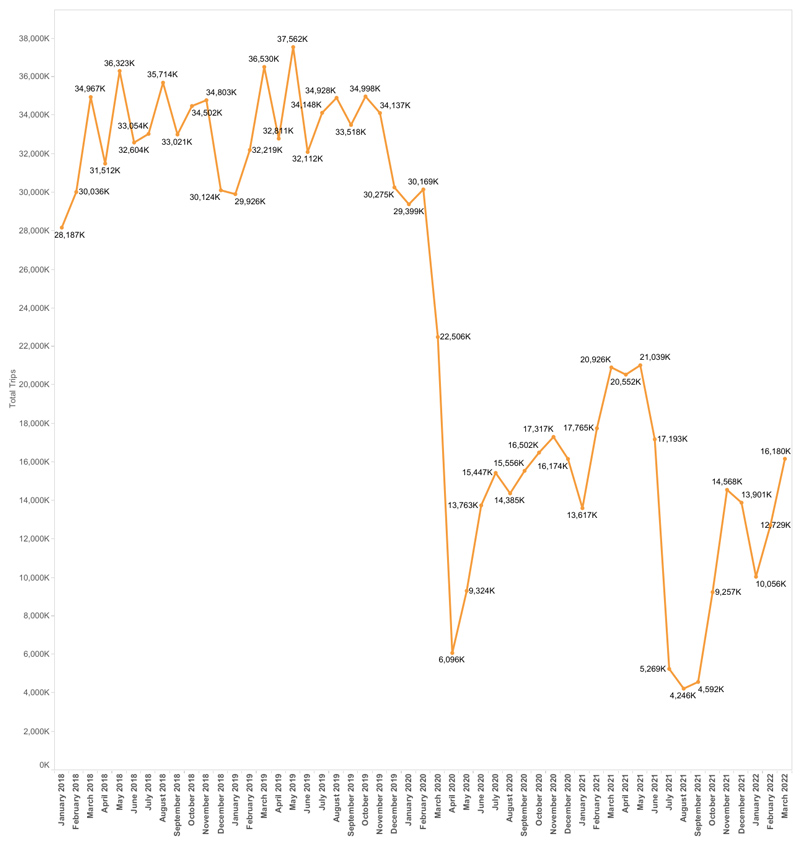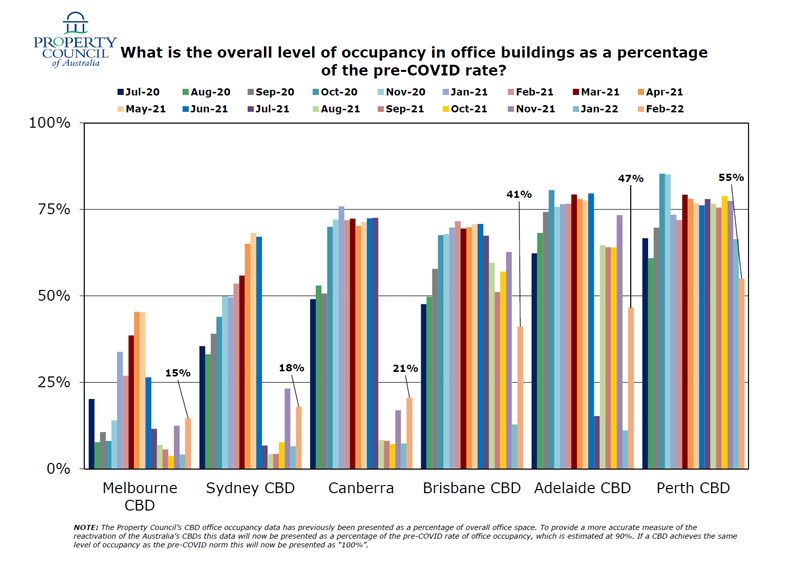Anecdotal evidence suggests that knowledge workers are gradually returning to work. Just not full time. The most popular arrangements seem to be 1 to 3 days per week in the office with other shifts at home. Other businesses are experimenting with a four day work week, but not even all of those days have to be in the office.
If I can save travel time for our employees, who often live an hour out, I will. Giving them back their time helps us to retain them. I think we will return to the office 2 to 3 days per week. Most workplaces that can do it, are going to go agile, with greater flexibility offered to staff. It helps us reduce our costs too. Two years ago even during something like the floods or strikes we’ve had recently, we’d still expect people in office. Now it’s accepted that contact centre staff can work from home.
General Manager, Customer Contact Centres at a large facilities management group
Public transport numbers tell the story
If it’s true that office workers are returning to work then we would expect this to be reflected in the number of people taking public transport into and out of the CBDs of our capital cities.
The graph below shows Sydney monthly public transport numbers from January 2018 to March 2022. We see an immediate and significant drop off from normal levels in February 2020 to around 20% of normal capacity by April 2020. This of course corresponds to the initial COVID wave and lockdowns.

The numbers rebound to about 50% of usual traffic by early 2021 before crashing again for the 2021 lockdowns. Data for the end of 2021 and early 2022 suggest a gradual rebound is underway, however passenger numbers are still only around 30% to 40% of what they were pre-pandemic. A similar pattern can be found in the Melbourne data, which saw passenger patronage fall to 10% of usual levels in 2020.
Even Perth, which suffered the fewest lockdowns and, until recently, the fewest cases of COVID saw transport use fall 30% below normal levels in 2020 and 2021. In the wake of Omicron’s arrival in WA, passenger numbers are currently 40% down on what they would be usually. In Queensland, which would normally see 50 million trips per quarter by public transport, that has been down to less than 30 million per quarter for the past two years.
While people do take public transport for many other reasons, and have had plenty of incentives to stay off trains and buses in the last couple of years, it’s reasonable to assume that some proportion of this reduction in public transport usage is due to workers staying at home.
Office occupancy rebounds – kind of
The Property Council of Australia publishes monthly figures on office occupancy in Australia’s capital cities. Here is a graph of occupancy rates in each city from July 2020 to February 2022, expressed as a percentage of the average pre-COVID occupancy rate.

If anything, these numbers show an even larger fall from the pre-COVID rate than the public transport figures do. Even in Perth where the occupancy rate, at least until Omicron, hovered around 75% of the pre-pandemic average it has now dropped to just 55% since the start of 2022.
In the other cities we see the same pattern of stuttering recovery in 2022 that we saw with the public transport numbers. Occupancy rates in the States that were hardest hit by lockdowns are still only 15% to 20% of pre-pandemic levels, as of February 2022.
So, are we going back to the office?
In short, not just yet. During the various lockdowns and restrictions most offices switched to homeworking, as we can see from the initial falls in both public transport numbers and office occupancy. In the first few months of 2022 both sets of figures have rebounded to roughly where they were before the arrival of Omicron in Australia.
We can assume that, barring future waves of COVID variants, the recovery will follow the patterns we saw in 2020 and 2021 following earlier waves. Those recoveries maxed out at around 50% to 75% of pre-pandemic levels, depending on how hard-hit the State was. That corresponds nicely to most staff returning to the office 2 to 3 days a week, which is what the leaders we spoke to for our upcoming report on The Future of Work in the Contact Centre and CX Industry told us they were doing. It’s nice to have corroboration though!
It’s still too early to tell if homeworking and flexible working have had a chance to become ingrained enough in our work culture to survive long-term, or if they will just prove to be blips we look back on fondly in 20 years time. Our gut says they’re here to stay but we can track that by seeing how these public transport and office occupancy numbers evolve over the next 6 months.
Even the most recalcitrant senior leaders have embraced working from home. If they don’t believe in it and buy into it, they can go to the office and sit on their own! It’s a tidal wave of change and you can get washed away by it or surf it. Sometimes the market tells you what you need to do so clearly that ignoring it would be folly.
Head of Wealth Contact Centres at a Big 4 Bank

